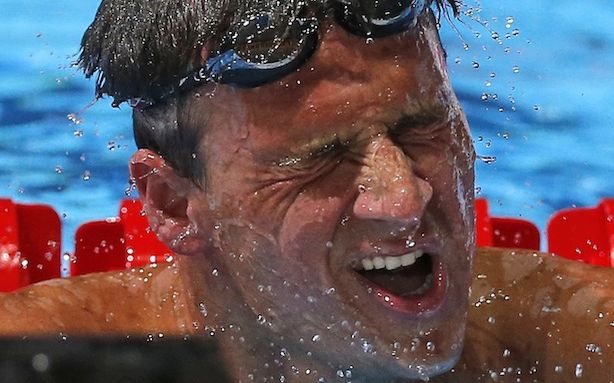Beyond the excitement of one future Olympic host putting a Torch into Space, and another passing the 1,000 days to go barrier, there was one story last week that largely passed the Olympic world by.
This concerned the most unfortunate of mishaps experienced by the American swimming star Ryan Lochte.

On a visit to his old Florida training base the five-time Olympic champion – and heir to the throne vacated by the now retired Michael Phelps – was greeted by an enthusiastic female fan.
This may not seem too terrifying a prospect but, with Lochte clearly lacking the security of other celebrity heartthrobs, his reaction to the girl running and jumping at him involved catching her, at which point both tumbled to the ground. While the fan was unharmed Lochte suffered a torn ligament and sprained another in his left knee, and will be on the sidelines for a lengthy spell as a result.
This marks the latest in a bizarre catalogue of mishaps involving the American. In 2007, he fractured his foot skateboarding, the following year he damaged his shoulder falling out of a tree during a game of hide and seek, and in 2009 he tore the menusus in his left knee – apparently by break dancing,
This is by no means an exhaustive list and, like no other, Lochte seems to combine bad luck with a sense of adventure and, some might say, outright stupidity.
He is far from the only sportsman to have experienced an injury bordering on the outlandish.
Belgian tennis star Kim Clijsters turned her ankle and then – to make matters worse – had her toe stamped on when limping off the dance-floor at a cousins wedding. High Jumper Blanka Vlasic, meanwhile, showed up for the qualification round of the 2009 World Championships in Berlin sporting a bandage after unintentionally smashing her head against a door. She did still win the final.
Footballers, maybe not unsurprisingly, have suffered their fair share of unusual mishaps. Spanish goalkeeper Santiago Canizares was ruled out of the 2002 FIFA World Cup after dropping a bottle of aftershave on his foot, Arsenal defender Steve Morrow broke his arm after he was picked up, then dropped, by his captain Tony Adams during post-match celebrations, while Rio Ferdinand once strained a tendon in his ankle simply by resting his leg on a sofa while watching television.
Some of these examples, and particularly those involving Lochte, provoke laughter as much as sympathy. But in a general sense there is simply nothing more infuriating for a sportsman than suffering an injury.
I know this from a personal experience – in my most amateur of careers as a runner – where injury has frequently put paid to that elusive chance of a new personal best. Although I have been lucky in terms of serious injuries I developed a knack of developing mishaps in the final week before a major race, and producing performances even more mediocre than targeted as a result.
For a professional athlete whose whole reputation, not to mention earnings, rests on performance, this sense of frustration can be multiplied countless times.
To do everything right in the build-up only for it to all go wrong at the last minute and having all those months of preparation deemed suddenly worthless. Worst of all, to not be able to practice your craft and instead be confined to such menial training methods as aqua-jogging in a swimming pool.
From the recent past of British athletics, three injury hit figures spring to mind: Dean Macey, Dame Kelly Holmes and a post-2003 Paula Radcliffe. For these three it always appeared a case of when not if the “i-word” would strike. For Dame Kelly, it all ultimately came good in one glorious double gold medal winning week in Athens in 2004, but for all the great things the other two achieved – without injury they would have been greater still.
It is not just the athletes themselves who suffer due to injuries. National federations are often dependent on individuals to hit performance-related targets which impact future funding, while the success of Championships can be put into question by injuries ruling out star-performers.
At the International Sports Events Management Conference in London last week, we learned about the meticulous planning which goes into hosting any event – bidding, facilities, sponsorship, mascots, ticket-sales and so on. Making sure the top athletes are present is generally out of the organizers’ control but is no less important.
Think of Chinese hurdler Liu Xiang and his agonizing exit in the heats at Beijing 2008. For all the success of the Games and of China, they were just missing the icing on top of the cake, something which a Liu victory would have produced. Michael Johnson did this at Atlanta 1996, Cathy Freeman did likewise at Sydney 2000, while Jessica Ennis and so many others did also at London 2012.
While the poor ticket sale produced the brunt of the criticism, the absence of Ennis – as well as David Rudisha, Sanya Richards-Ross and those missing for doping rather than injury-related reasons, certainly contributed to the comparative damp squid that was the 2013 World Championships in Moscow.
Contact the writer of this story at gary.anderson@insidethegames.biz. Inside the Games is an online blog of the London Organizing Committee that staged the 2012 London Games. The blog continues to cover issues that are important to the Olympic Movement. This article is reprinted here with permission of the blog editors.